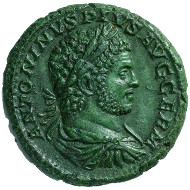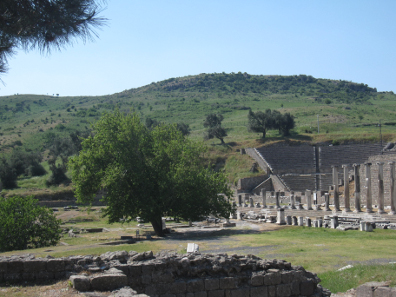with the kind permission of the MoneyMuseum, Zurich.
Why is it that for centuries – or rather thousands of years – the head has served as the motif for the side of a coin? And why has this changed in the last 200 years? Ursula Kampmann poses these questions in her book ‘MenschenGesichter,’ from which the texts for our new series are taken.
Roman Imperial Times. Caracalla (198-217). As, 215. Cuirassed bust of Caracalla with laurel wreath r., wearing the military cloak. Rev. Asclepius of Pergamum with the serpent-entwined staff standing in frontal position, Telesphorus to the left (Greek: bringer of completion), and Omphalus. © MoneyMuseum, Zürich.
The year is 212. Septimius Severus just died and left his two sons Caracalla and Geta as heirs to the imperial throne. It is laid down that Caracalla is the future ruler, while Geta is supposed to aid him. Geta, however, doesn’t want to comply. He collects allies in order to dethrone his brother. The plot fails. Caracalla takes a bloody revenge. He executes 20,000 conspirators. His brother he kills with his own hands, using his own sword, on the lap of his mother where the instigator has sought refuge. This cruel fratricide was to burden Caracalla for all his life. He had nightmares and suffered from psychosomatic illnesses. But a sick emperor was the last thing Rome needed at the beginning of the 3rd century. The migration of peoples was in full swing. In the east, the Parthians once again tried to conquer parts of the Roman Empire. Hence, conducting war was the main activity of the emperor – conducting war and visiting the then specialists in emotional illnesses, i.e. the healing deities.
Admittedly, the ability to treat wounds and diseases of civilization was much advanced in Roman times, but there was still any number of illnesses which the doctors couldn’t prescribe an effective cure against. These patients sought refuge in the sacred groves of Asclepius or Aesculapius, of Apollo or Amphiaraos. There, they were informed by the priests that an illness might result from the humans not living in accordance with divine law, and that the gods had sent the disease to let them know so that they would make sure to restore peace between god and the world. Incubation was used for the patients to get into contact with the supernatural, and they were told in their dreams about ways and means to get some relief.
The sanctuary of Asclepius at Pergamum. Photograph: KW.
Caracalla dreamt his relieving dream at Pergamum. We don’t know how the priests there assisted him so that he was at peace with the gods at last. At any rate, the emperor remained grateful to Asclepius for his entire life. He not only made great donations and granted privileges to Pergamum and its sanctuary but honored the god in making him known in the entire empire thanks to a large and widely disseminated coin emission that depicted the god in exactly the same way as he was worshipped in Pergamum: accompanied by Telesphorus, the little helper of Asclepius, who brought – either good or bad – completion of the illness, and Omphalos.
In the next chapter, you’ll learn how Diocletian, a soldier of quite humble birth, managed to lay the foundation of a new Rome.
All sections of the series can be found here.
The book ‘MenschenGesichter’ is available in printed form from the Conzett Verlag website. It soon will be translated to English …








